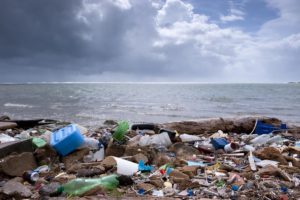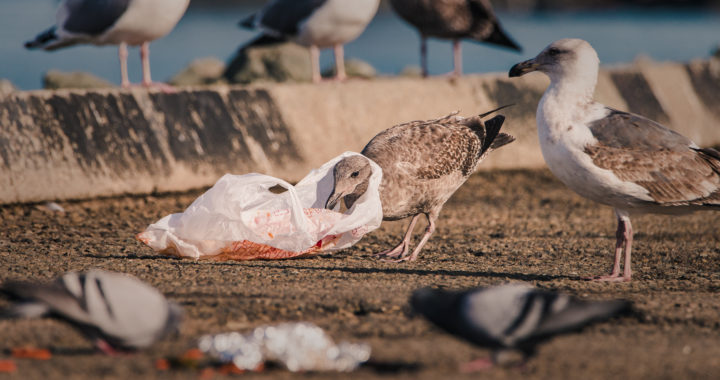Plastic pollution is a growing environmental problem which kills countless animals every year and may be threatening human health. But the problems with plastic pollution are self-inflicted, and can be mitigated if we decide to do so.
That was the message presented by Ohio State University’s Sea Grant program educator Jill Bartolotta, Wednesday, at Cuyahoga Community College’s Westshore campus.
Bartolotta’s wide-ranging talk covered the ways that plastic enters the environment, the harm it causes, the failure of plastic recycling, Cuyahoga County’s plastic bag ban, and other efforts to reduce the amount of plastic pollution.
“Plastic is awesome when it is used for its intended purpose,” said Bartolotta. As a material plastic is inexpensive, lightweight, and durable, with many important uses, including medical applications and food preservation. But plastic has a critical characteristic that makes it problematic for animal health, human health, and the environment in general.
“Plastic does not break down into anything useful,” she said. “Plastic was never intended to be in the natural environment.”

96 percent of litter collected in Great Lakes beach clean-ups is plastic.
Discarded plastic that remains in the environment breaks apart under the effects of sunlight, wind, and rain into smaller and smaller fragments. But it never becomes anything other than plastic. And the smaller it gets, the more pathways it has to enter our drinking water and food.
Plastic that has not yet broken down has catastrophic impacts on the environment. Plastic bags and plastic film are swallowed by animals that mistake them for food. Plastic lines, netting, and balloons entrap animals, frequently killing them. And plastic litter fouls land and water across the planet.
Ninety-six percent of debris collected in beach clean-ups around the Great Lakes is plastic, said Bartolota.
But the greatest harm from plastic occurs when it is reduced to microplastic shards, pellets, or fibers. These particles are ingested by animals and people and while the impact on human health is still unclear, studies on animals have found that microplastics disrupt their hormone systems, nervous systems, and digestive systems. In animals, feeding, reproduction, growth, and movement are all affected by microplastics in the environment.
Microplastics have been found in plankton, the very base of the food chain. Plankton is consumed by small organisms, and those organisms are consumed by larger organisms, and so on, moving plastic up the food chain. Today, microplastics are found in our drinking water – bottled and tap – and in our food.
“You are eating, drinking, and breathing plastic every day,” said Bartolotta.
A significant source of plastic in the environment is the shedding of plastic microfibers from synthetic fabrics like polyester, rayon, and nylon. A single washing of a fleece garment can release between 10,000 and 100,000 plastic microfibers, said Bartolotta. Another source is beauty products. Although plastic microbeads were prohibited in some beauty products in 2015, they are still added to products that were not covered by the law.
Microplastic in the environment is impossible to remove, so we should take steps to prevent plastic from entering the environment in the first place, said Bartolotta.
Cuyahoga County’s plastic bag ban, which prohibits retailers from providing most plastic bags, is in effect now, although it won’t be enforced until the summer. A six-month phase-in period was included in the law to give retailers time to use stocks of bags they already had and educate consumers. While paper bags and reusable bags each have their own environmental impacts, they do not contribute to plastic pollution, said Bartolotta.
But bags are just one source of plastic in the environment, and despite growing awareness of the harm plastic is causing, the use of plastic continues to grow. Since 2010 worldwide annual production of plastic has grown from 270 million metric tons to 359 million metric tons. Global plastic production is expected to reach 1 billion metric tons by 2040.
In 2015, researchers found that since 1950 humans had generated 8.3 billion metric tons of plastics. 6.3 billion tons of that total had already become waste. Of that waste total, only 9 percent was recycled.
Today, the percentage of plastic being recycled is almost certainly lower.
“Recycling has collapsed,” said Bartolotta. The loss of Asian markets for recycled plastic, contamination of plastic collected for recycling, and the expense of sorting the material has made recycling uneconomic. “It is cheaper to make new plastic than it is to recycle old plastic,” said Bartolota.
So, what can we do about plastic pollution? “The solution is super simple,” said Bartolotta. “Refuse and reuse. Say ‘no’ to single-use plastic, reuse what you already have, and buy less stuff.”
But moving away from our ‘throw-away’ culture won’t be easy. Even a step as simple and obvious as replacing single-use plastic bags faces strong opposition from plastic industry groups and some retailers. Many business leaders believe consumers won’t accept more expensive or less convenient substitutes for single-use plastic products, even if the substitution reduces plastic pollution.
Bartolotta disagrees.
Research and the results of a pilot project with a group of Ohio restaurants which reduced their use of plastic straws, boxes, and bags has convinced Bartolotta that consumers don’t oppose the changes.
In fact, customers’ responsive were “overwhelmingly positive,” she said. “Restaurants did not lose business, and wait staffs did not lose tips.”
Consumers who are concerned about plastic pollution can push for change by asking businesses why they are still using plastic, said Bartolotta. “If more and more consumers have these conversations with business, business will respond,” she said. “Plastic is in the environment because of us. All these problems are completely preventable.”
January 31, 2020
photo credits:
seagull image: Cuyahoga County http://sustainability.cuyahogacounty.us/img_sustainability/en-US/BYOBags/BagAroundGull.jpg
beach image: https://pixfeeds.com/images/topic/2918/1200-2918-environmental-pollution-photo1.jpg
